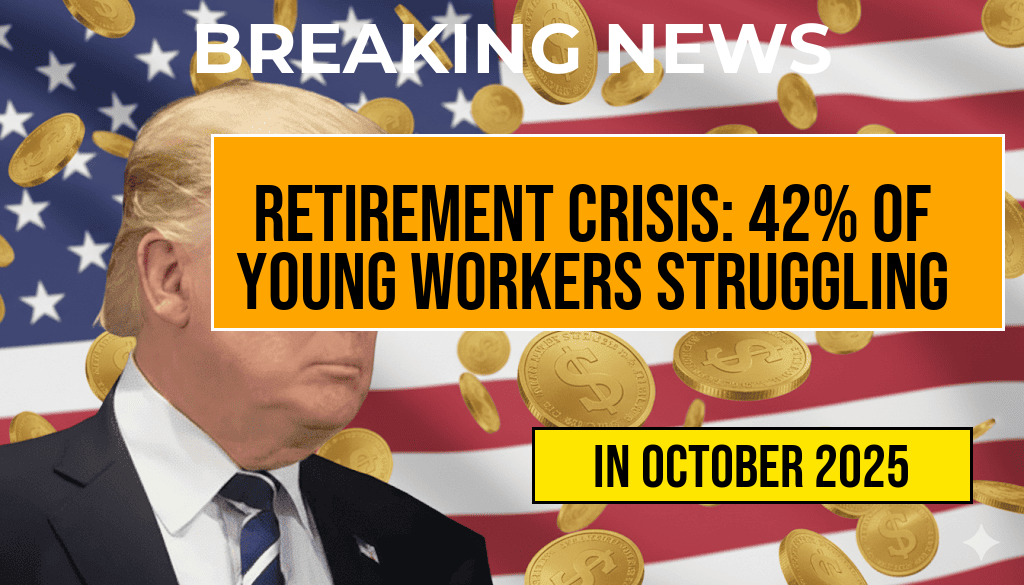Millions of younger workers are facing a mounting retirement savings crisis, as recent studies reveal that nearly 42% of individuals aged 25 to 40 have no spare cash to contribute toward their retirement funds. This alarming figure underscores a growing financial vortex—a complex web of economic pressures that leaves many unable to build a nest egg for their later years. With rising costs of living, stagnant wages, and insufficient employer-sponsored plans, the gap between current financial stability and future security widens. Experts warn that these trends threaten to increase reliance on social safety nets and could compromise retirement readiness for a significant portion of the workforce. As policymakers and financial institutions grapple with this crisis, understanding the underlying causes and potential solutions becomes critical to reversing the trend and securing financial futures for younger Americans.
The Scope of the Retirement Savings Shortfall
Key Findings from Recent Surveys
- According to the Employee Benefit Research Institute (EBRI), 42% of workers aged 25–40 have no retirement savings at all.
- Nearly 60% of respondents report feeling unprepared for retirement, citing insufficient income and high living expenses as primary barriers.
- Less than half of private-sector employees participate in employer-sponsored retirement plans, such as 401(k)s, leaving many to rely solely on Social Security.
Impact on Future Retirement Security
| Age Group | Average Savings | Recommended Savings | Gap |
|---|---|---|---|
| 25–34 | $2,500 | $50,000 | $47,500 |
| 35–44 | $8,000 | $150,000 | $142,000 |
| 45–54 | $15,000 | $250,000 | $235,000 |
Underlying Causes of the Crisis
Economic Factors and Cost of Living
Stagnant wages combined with rising housing, healthcare, and education costs have eroded disposable income for many younger workers. According to the Bureau of Labor Statistics, consumer prices have increased by over 20% in the past decade, outpacing wage growth in most sectors. This squeeze leaves little room for saving, especially when unexpected expenses arise.
Limited Access to Retirement Plans
While employers increasingly offer retirement plans, many smaller firms lack such benefits, leaving employees to fend for themselves. Freelancers, gig workers, and part-time employees often miss out entirely, further widening the savings gap. Federal initiatives like the My Retirement Plan aim to expand access, but adoption remains slow.
Behavioral and Psychological Barriers
Financial literacy gaps and psychological factors also play a role. Many younger individuals underestimate future needs or feel overwhelmed by debt, leading to procrastination or avoidance of savings altogether. Without targeted education and incentives, these behaviors are unlikely to change significantly.
Consequences and Risks
Increased Dependence on Social Safety Nets
As savings dwindle, a growing number of retirees may rely heavily on Social Security, which is not designed to fully replace pre-retirement income. The Social Security Trustees project that without reforms, benefits may be insufficient to support a comfortable retirement for many recipients, placing additional strain on federal resources.
Potential Rise in Poverty Among Elderly
Data from the U.S. Census Bureau indicates that poverty rates among seniors are higher than among other age groups, partly due to inadequate savings. This trend could intensify if current patterns persist, leading to increased economic insecurity among aging populations.
Policy and Private Sector Responses
Legislative Initiatives
Efforts to address the crisis include proposals to bolster automatic enrollment in retirement plans, expand access to individual retirement accounts (IRAs), and incentivize employer participation. The Secure Act 2.0, for example, aims to make retirement savings more accessible and portable for gig workers and part-time employees.
Private Sector Innovations
Financial institutions are developing new tools to encourage savings among young workers, such as personalized financial coaching, automatic escalation features, and flexible contribution options. Employers are also exploring innovative benefits packages to promote financial wellness.
Steps for Younger Workers to Bolster Retirement Readiness
- Start saving early, even with small contributions, to benefit from compound growth.
- Maximize participation in employer-sponsored retirement plans whenever available.
- Seek financial education resources to improve literacy and confidence in managing money.
- Balance debt repayment with savings goals to establish a solid financial foundation.
- Explore alternative savings options, such as Roth IRAs or health savings accounts, to diversify retirement planning strategies.
Addressing the retirement savings crisis requires concerted efforts from policymakers, employers, and individuals alike. As the financial vortex continues to tighten around younger workers, proactive steps and systemic reforms are essential to prevent a future where financial insecurity in retirement becomes the norm rather than the exception. Recognizing and tackling the root causes today can help secure a more stable and dignified retirement for upcoming generations.
Frequently Asked Questions
What is the “Financial Vortex” and how does it impact retirement savings?
The “Financial Vortex” refers to the cycle of financial challenges that trap many younger workers, making it difficult to save for retirement. This cycle includes factors like high expenses, debt, and insufficient income, leading to a significant portion of workers having no spare cash for savings.
Why are so many younger workers unable to save for retirement?
Many younger workers face financial hurdles such as low income, high living costs, and debt burdens. As a result, approximately 42% have no spare cash to contribute toward retirement, leaving their future financial security at risk.
What are the potential consequences of not saving for retirement early?
Not saving early can lead to , forcing individuals to work longer or rely heavily on social security and other support systems. The earlier savings are missed, the more difficult it becomes to accumulate adequate funds due to compound interest effects.
What strategies can younger workers adopt to improve their retirement savings?
Workers can focus on creating budgets, reducing debt, and setting up automatic contributions to retirement accounts. Seeking financial education and taking advantage of employer retirement plans can also significantly enhance savings over time.
How can policymakers address the retirement savings crisis highlighted in the article?
Policymakers can implement measures such as expanding access to retirement plans, providing financial literacy programs, and offering tax incentives to encourage saving. These initiatives aim to reduce the number of workers with no spare cash for retirement and improve overall financial security.






